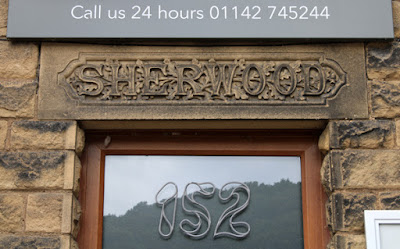 |
| The Greenmoor Rock at Chancet Wood above Abbey Lane |
Leaving Linden Avenue and continuing down Abbey Lane, the Edwardian housing that grew up around the expanding area of Woodseats changes to predominantly interwar developments, which occupies the slopes beneath Chancet Wood and along the road towards Beauchief.
 |
| A pair of sandstone faced semi-detached houses |
Walking for only 100 metres or so, I passed by a series of stone faced interwar houses – both detached and semi-detached – where the sandstone used is quite different to those that I had seen earlier on my walk at the former Woodseats Council School and St. Chad's church.
 |
| A sandstone faced detached house |
I didn’t get close enough to examine them, but the distinctly orange colouration very much reminded me of the ‘ginger nut’ hued sandstone that I had encountered when exploring Handsworth and the surrounding area during the early months of the COVID-19 Pandemic lockdown.
 |
| Edwardian semi-detached houses on Abbey Lane |
The adjacent small speculative development, comprising three pairs of large Edwardian semi-detached houses, are also faced in a sandstone with a distinct blue/grey body with marked orange colouration that also looks like the stone that I have always assumed to be from the now redeveloped Handsworth Quarries.
 |
| Window dressings made from Jurassic oolitic limestone |
The dressings, however, are not a massive medium to coarse grained sandstone, which would normally be expected in Sheffield, but a Jurassic oolitic limestone. It has developed a honey coloured patina similar to that which I had often seen on Bath Stone, when working in the building restoration industry in London. Ancaster limestone from Lincolnshire is generally used in the north, but Bath Stone has been specified by Sheffield architects, as seen at Crookes Cemetery.
 |
| Jurassic oolitic limestone used for an entrance |
Walking further down Abbey Lane towards the entrance of Abbey Lane Cemetery, I was interested to see that the strike of the Greenmoor Rock switches from a NNW-SSE to a SW-NE direction. When travelling up the Chesterfield Road from Meersbrook to Meadowhead, there is no obvious change in the incline of the slope, but there is actually a reversal in the direction of the dip of the Greenmoor Rock from south to north.
 |
| Measurements of the angle of dip in the Greenmoor Rock |
Having obtained another perspective on the walk that I had undertaken from Chancet Wood to Ladies Spring Wood a few years ago, I carried on down to the entrance of Abbey Lane Cemetery, where I discovered a wonderful carved lintel above the entrance to the John Fairest Funeralcare premises at Sherwood House.

No comments:
Post a Comment